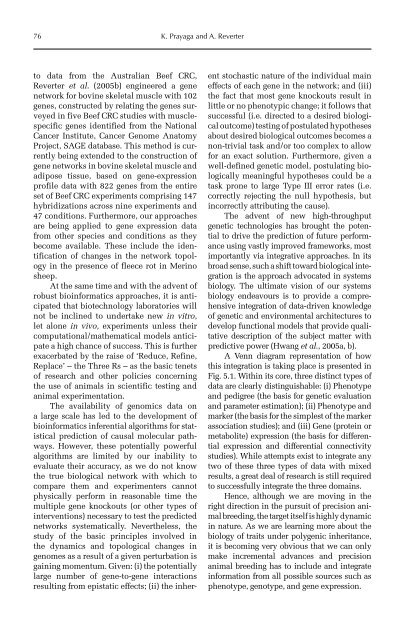Redesigning Animal Agriculture
Redesigning Animal Agriculture
Redesigning Animal Agriculture
Create successful ePaper yourself
Turn your PDF publications into a flip-book with our unique Google optimized e-Paper software.
76 K. Prayaga and A. Reverter<br />
to data from the Australian Beef CRC,<br />
Reverter et al. (2005b) engineered a gene<br />
network for bovine skeletal muscle with 102<br />
genes, constructed by relating the genes surveyed<br />
in five Beef CRC studies with musclespecific<br />
genes identified from the National<br />
Cancer Institute, Cancer Genome Anatomy<br />
Project, SAGE database. This method is currently<br />
being extended to the construction of<br />
gene networks in bovine skeletal muscle and<br />
adipose tissue, based on gene-expression<br />
profile data with 822 genes from the entire<br />
set of Beef CRC experiments comprising 147<br />
hybridizations across nine experiments and<br />
47 conditions. Furthermore, our approaches<br />
are being applied to gene expression data<br />
from other species and conditions as they<br />
become available. These include the identification<br />
of changes in the network topology<br />
in the presence of fleece rot in Merino<br />
sheep.<br />
At the same time and with the advent of<br />
robust bioinformatics approaches, it is anticipated<br />
that biotechnology laboratories will<br />
not be inclined to undertake new in vitro,<br />
let alone in vivo, experiments unless their<br />
computational/mathematical models anticipate<br />
a high chance of success. This is further<br />
exacerbated by the raise of ‘Reduce, Refine,<br />
Replace’ – the Three Rs – as the basic tenets<br />
of research and other policies concerning<br />
the use of animals in scientific testing and<br />
animal experimentation.<br />
The availability of genomics data on<br />
a large scale has led to the development of<br />
bioinformatics inferential algorithms for statistical<br />
prediction of causal molecular pathways.<br />
However, these potentially powerful<br />
algorithms are limited by our inability to<br />
evaluate their accuracy, as we do not know<br />
the true biological network with which to<br />
compare them and experimenters cannot<br />
physically perform in reasonable time the<br />
multiple gene knockouts (or other types of<br />
interventions) necessary to test the predicted<br />
networks systematically. Nevertheless, the<br />
study of the basic principles involved in<br />
the dynamics and topological changes in<br />
genomes as a result of a given perturbation is<br />
gaining momentum. Given: (i) the potentially<br />
large number of gene-to-gene interactions<br />
resulting from epistatic effects; (ii) the inher-<br />
ent stochastic nature of the individual main<br />
effects of each gene in the network; and (iii)<br />
the fact that most gene knockouts result in<br />
little or no phenotypic change; it follows that<br />
successful (i.e. directed to a desired biological<br />
outcome) testing of postulated hypotheses<br />
about desired biological outcomes becomes a<br />
non-trivial task and/or too complex to allow<br />
for an exact solution. Furthermore, given a<br />
well-defined genetic model, postulating biologically<br />
meaningful hypotheses could be a<br />
task prone to large Type III error rates (i.e.<br />
correctly rejecting the null hypothesis, but<br />
incorrectly attributing the cause).<br />
The advent of new high-throughput<br />
genetic technologies has brought the potential<br />
to drive the prediction of future performance<br />
using vastly improved frameworks, most<br />
importantly via integrative approaches. In its<br />
broad sense, such a shift toward biologi cal integration<br />
is the approach advocated in systems<br />
biology. The ultimate vision of our systems<br />
biology endeavours is to provide a comprehensive<br />
integration of data-driven knowledge<br />
of genetic and environmental architectures to<br />
develop functional models that provide qualitative<br />
description of the subject matter with<br />
predictive power (Hwang et al., 2005a, b).<br />
A Venn diagram representation of how<br />
this integration is taking place is presented in<br />
Fig. 5.1. Within its core, three distinct types of<br />
data are clearly distinguishable: (i) Phenotype<br />
and pedigree (the basis for genetic evaluation<br />
and parameter estimation); (ii) Phenotype and<br />
marker (the basis for the simplest of the marker<br />
association studies); and (iii) Gene (protein or<br />
metabolite) expression (the basis for differential<br />
expression and differential connectivity<br />
studies). While attempts exist to integrate any<br />
two of these three types of data with mixed<br />
results, a great deal of research is still required<br />
to successfully integrate the three domains.<br />
Hence, although we are moving in the<br />
right direction in the pursuit of precision animal<br />
breeding, the target itself is highly dynamic<br />
in nature. As we are learning more about the<br />
biology of traits under polygenic inheritance,<br />
it is becoming very obvious that we can only<br />
make incremental advances and precision<br />
animal breeding has to include and integrate<br />
information from all possible sources such as<br />
phenotype, genotype, and gene expression.










